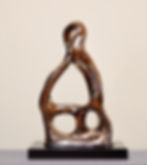Lawrence
Ceramic artist

Latest Works















I first became fascinated by clay in college, and have spent much of the decades since exploring the many possibilities ceramics offers.
My first passion was wheel throwing, which was my main focus in making all sorts of functional pottery. While I still enjoy it, I came to appreciate the many forms clay can take that are not possible on the wheel. For example, I founded and ran for years a business making ceramic lighting fixtures, for which molds and casting were the right approach. Lately, I've come to do more hand-building than throwing or casting, since it offers the possibility of even greater freedom of form.
The benefit of hand-building is that the work is freed from the constraints imposed by other processes. Thrown ware, for example, is necessarily symmetrical around an axis. Cast ware isn't limited to a single line of symmetry but still involves a distinct inside and outside. Hand-building dispenses with both limitations, but poses its own unique challenges.
Clay resists being built up into the shapes I envision – when moist enough for alteration, it is too weak to support much weight. As it stiffens and grows stronger, though, it shrinks and resists joining to still wet clay. When I get the timing right, though, I can build the curvilinear organic shapes I like.
A key aspect of any ceramic piece is its surface, which in my case is usually glazed. I find glaze chemistry intriguing and continually discover new dimensions to the process of finishing ceramics. I've prospected for rocks of suitable composition to make glazes and continually experiment with other additives like manganese, tungsten and bismuth to assess their effects. My glazes run the gamut from sturdy functional glazes to metallic and crystalline finishes that surprise and delight the eye.
When a piece is ready for glazing, I choose the particular glaze that best suits its shape.